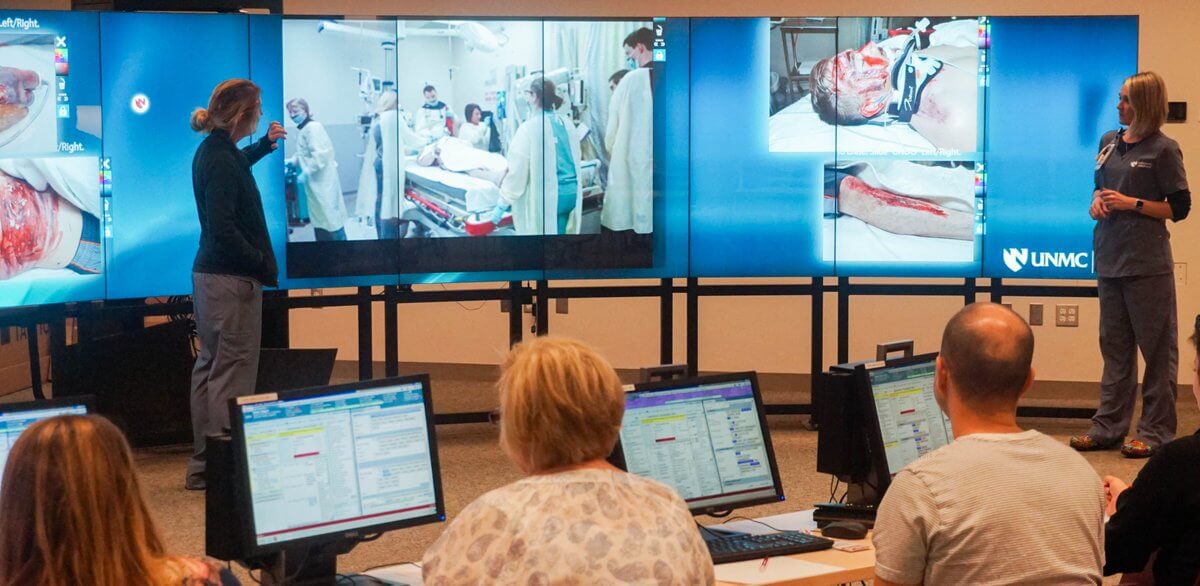Modeling and Simulation Technologies are Reshaping Health Care Education
In the world of health care education, AVI-SPL is a leader in installing emerging simulation technologies, from advanced human patient simulators and task trainers, to augmented, virtual and immersive reality, as well as the MultiTaction iWall.

AVI-SPL specializes in designing health care education environments where learners acquire knowledge, and experience hands-on training in a wide range of realistic but simulated healthcare environments. Under this paradigm, students practise using a wide range of simulation technologies until they become proficient in procedural and professional skills before encountering real-life patient care situations.
AVI-SPL’s mission to accelerate the adoption of modeling and simulation technology will reshape the way in which medical education is delivered.
The iWall is used to create a very realistic, hands-on, interactive, scenarios for students to learn and practise. It offers more than learning the “how-to” of a procedure. Up at the iWall, students learn how to relate and think through problems, and practise the critical thinking skills they will need under fire.
We spoke with Bill Schmidt, AVI-SPL Sales Director and Visualization Advocate.
The iWall is a Powerful Tool for Remote Learning
The MultiTaction solution has low bandwidth requirements with ultra-low latency, even replicating high-resolution video in perfect synchronisation with no loss of image quality. This makes the iWall a powerful tool for collaboration and remote learning.
AVI-SPL and MultiTaction recently partnered at the University of Nebraska Medical Center, (UNMC), iEXCEL center. Within the state of Nebraska, there are many rural and underserved communities, and iEXCEL desires to serve these remote communities and offer the same standard of training and technology across the state.
UNMC satellite campuses cannot count on a lot of bandwidth being available on demand, because the ISP providers in some areas of Nebraska are not always robust. This meant that AVI-SPL had to find a low bandwidth solution for collaborating across distance.
“The MultiTaction iWall is the ideal solution when bandwidth is a concern,” says Schmidt.

The first remote learning project is complete with the installation of an iWall 450 miles West of Omaha, in Scottsbluff. Nurses and Dental Hygienists at the Scottsbluff satellite campus can now connect in real time with Omaha via the iWall collaboration software, MT Canvus and Connect.
There is a server at each iWall location, and a third server to run Canvus Connect. Schmidt explains, “The bandwidth required for one iWall running Canvus to talk to a second iWall running Canvus is very low, yet it provides a great deal of functionality.”
iEXCEL plans for iWalls at several other sites in the State of Nebraska, with upcoming installations planned for Lincoln, and then Kearney. “With this network of iWalls, the students and faculty will be able to collaborate easily and in real-time across distance,” says Schmidt.
The MultiTaction solution has low bandwidth requirements with ultra-low latency, even replicating high resolution video in perfect synchronization with no loss of image quality.
MultiTaction solutions enable higher education institutions to change the paradigm of how they teach. The iWall creates an interactive classroom experience that better suits the way that learners of today absorb information. For health care education, the iWall provides a safe environment where students can learn without fear of harming a patient, and practise until they are ready to take excellent care of a patient.
Download the full case study to learn how the unique relationship between MultiTaction and AVI-SPL will transform health care education, as the iWall’s advanced visualization solutions enhance outcomes and lowers costs.

Leave a Reply